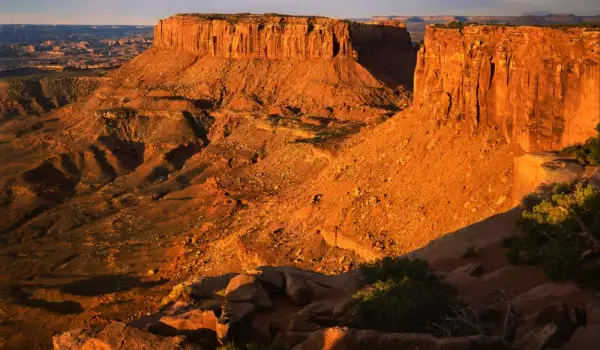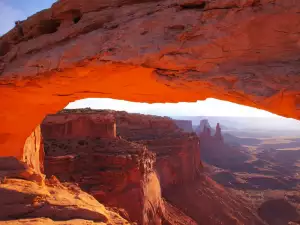Canyonlands National Park

Canyonlands National Park is located in Utah. Near the park is the town of Moab. The park attracts tourists with an incredible opportunity to see for themselves the grandeur of nature, which has been preserved from a time when prehistoric people lived there. Trees in the park live in an interesting way - in the dry years, they grow one or two new branches, and all the others die, for the tree to survive. The most beautiful view over the park opens at the site of Grand View Point Overlook.
In the area of national park Canyonlands people lived ten thousand years ago. Depending on the natural resources offered, the groups of people were moving in one direction or another area in order to survive. National Park Canyonlands is one of the last relatively undisturbed areas of the Colorado Plateau, which covers much of the Colorado River and its tributaries. Known as the high desert to an altitude of 7200 meters, the park offers tourists to Canyonlands very hot summers, cold winters and less than ten cm rainfall during the year.
Its area is over 1300 square kilometers and it really is a rugged corner of the earth. Water and wind have destroyed the rocks, they have created hundreds of beautiful canyons, towers, arches and hills. Canyonlands National Park was founded in 1964 when few people were familiar with this remote location.

This part of Utah has long been known to uranium seekers. The area remains as it always has been - difficult to access. Although the area has diverse ecosystems, geological processes have played a major role in shaping Canyonlands. Rare vegetation allows tourists to see large areas of bare rock that are over three hundred million years old- then was the time when they were formed. The origin of the large amount of small canyons located in this area can create a strange impression initially.
Most of the year, in Canyonlands, time seems to have stopped. The process of erosion is very slow and imperceptible. Tourists can rarely see the accidental fall of s a tone or a landslide. This even is considered lucky. Some of the destructive processes, however, run very fast. It is the lack of vegetation and abundance of rocks that make Canyonlands highly vulnerable in this respect. Flash floods constantly expand and deepen the canyons.
Much of the annual precipitation in Canyonlands occurs during the summer monsoons. These dramatic storms often last for less than twenty minutes, but can cause powerful floods, despite their brevity.
In this desert area, the temperature constantly fluctuates throughout the year and even during the day varies from low to high. In hot summer days the temperature can reach up to fifty degrees, and the cold summer nights can drop to fifteen degrees. Canyonlands National Park is split by the Colorado River in three divisions - one bears the poetic name Island in the Sky, the second is called The Needles and the third - The Maze. The most visited by tourists is the part of the park, which is called Island in the sky.
Although a desert area, the park is home to many species. Most animals that inhabit the national park Canyonlands are active at night, because then it is cooler. Here you can meet kangaroo rats, wood rats, skunks, mountain lions, foxes, bats and owls.
In addition, the park has deer, coyotes, porcupines, rabbits and many songbirds. In Canyonlands Park are also found rock squirrels, lizards, snakes, hawks and eagles. One of the animals in the park, which is uniquely adapted to life in the desert is the kangaroo rat. This rat lives its entire life consuming nothing but plants, its body produces all the water that is needed.















